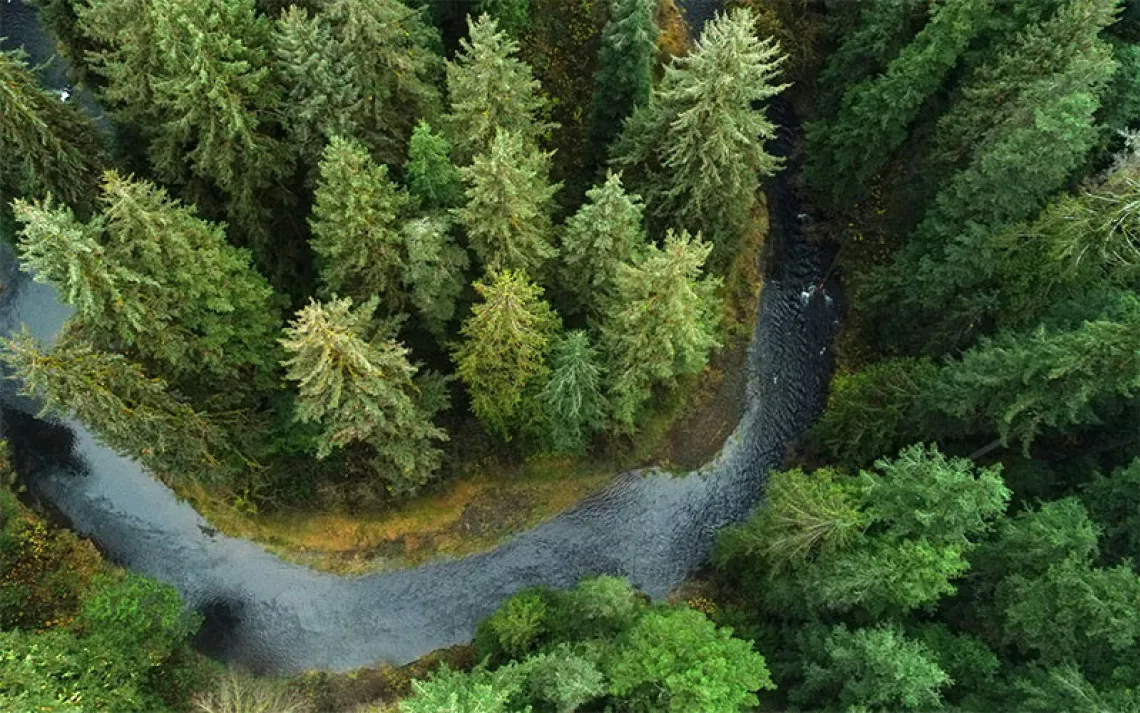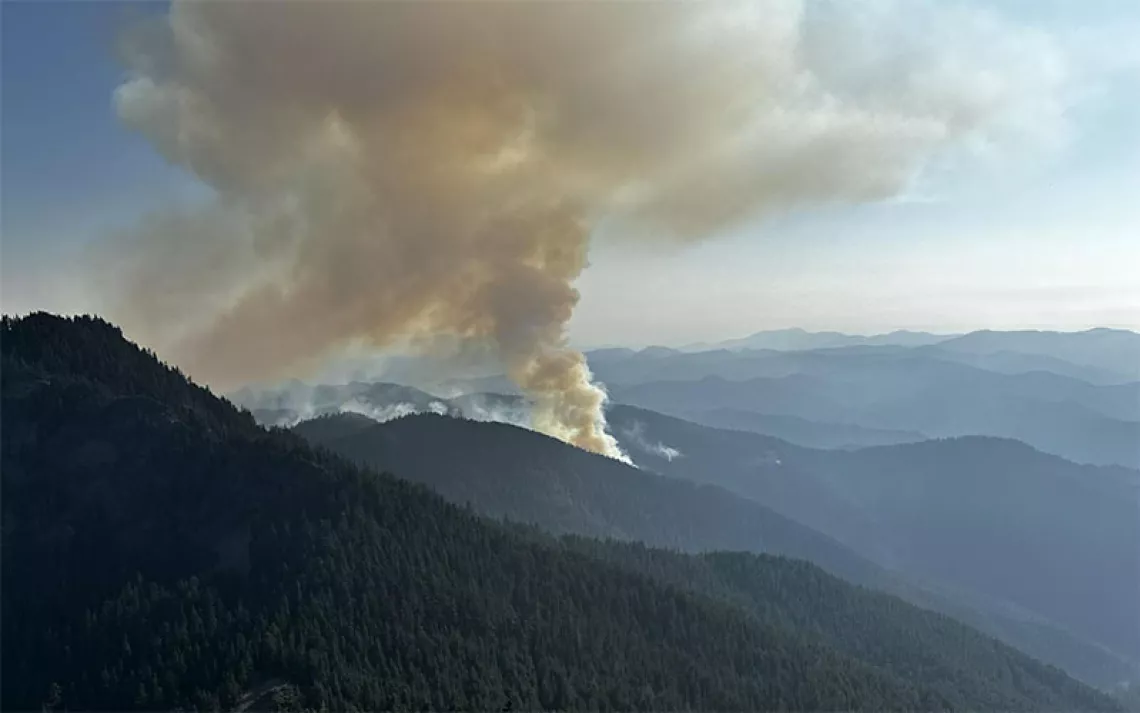Future Forests of America
Across the American West, forests are failing to regenerate after high-intensity wildfires, but that doesn't have to mean they're gone for good
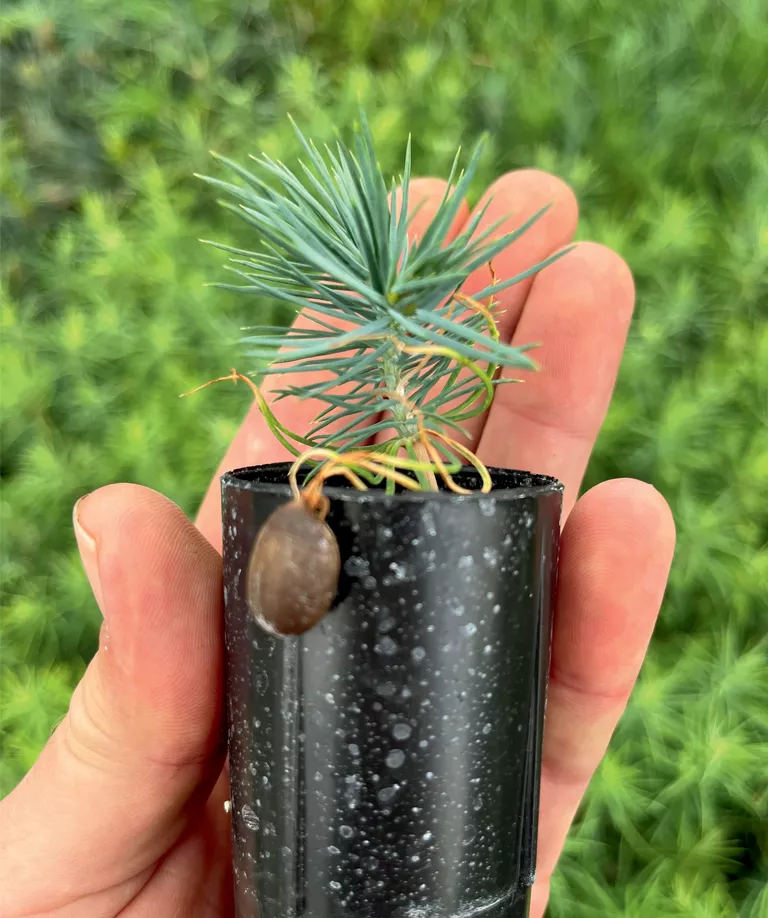
Photo by Pouli Sikelianos
ON A CLEAR, cold September morning, Gillian Trimber steered a white Chevy Silverado up the serpentine road into southwest Colorado's Mesa Verde National Park. Her headlights swept through the predawn gloom, illuminating yellow bursts of rabbitbrush, hillsides carpeted with scrub oak, and gnarled piñon pine and juniper, trees that together anchor a sparse, fragrant forest ecosystem. Following behind Trimber were several other vehicles, each laden with soil sensors and shovels, drill augers and duct tape. The most precious cargo was in the bed of Trimber's truck: 288 piñon pine and juniper seedlings, each a two-inch starburst of blue-green needles.
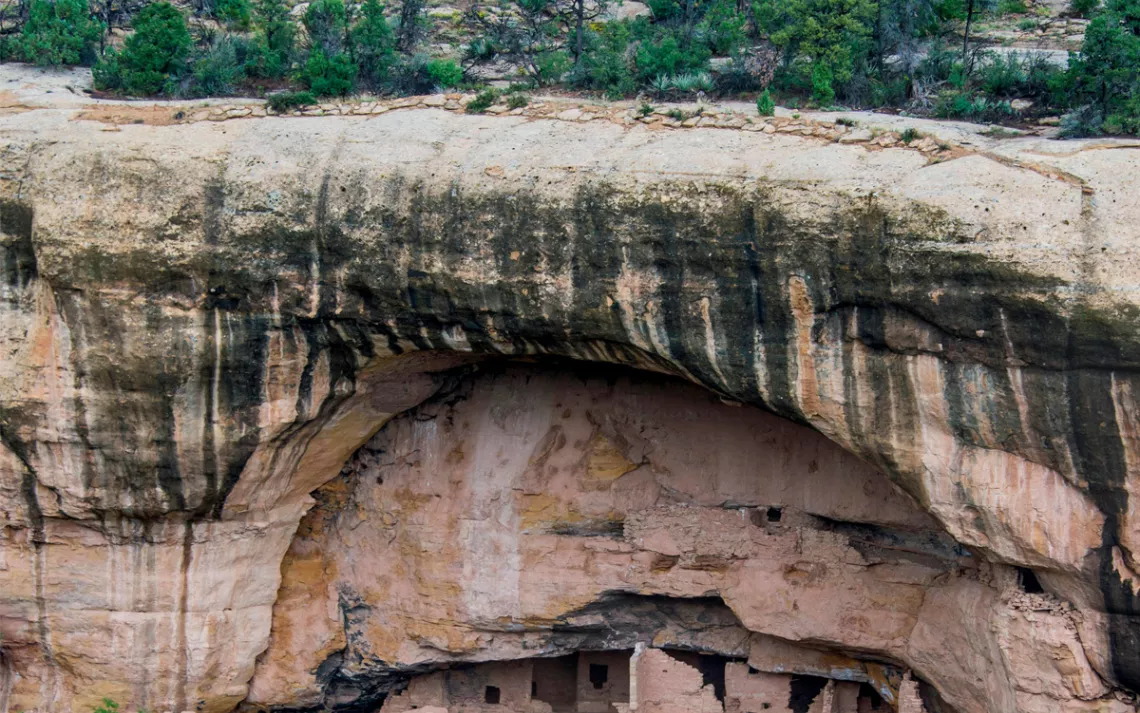
A burn scar above one of Mesa Verde National Park's iconic cliff dwellings. | Photo by Michael Runkel/Mauritius Images GmbH/Alamy Stock Photo
The seedlings were, in a sense, coming home. Trimber, a PhD student at Northern Arizona University, had collected seeds from Mesa Verde the year before with help from the National Park Service and several academic and government scientists. She had carefully tended them in a greenhouse, growing some in sterile soil and others in soil inoculated with mycorrhizal fungi—tiny filaments that help trees absorb soil nutrients and moisture. Now roughly eight months old, the seedlings were nestled in black plastic pots and traveling ever higher up a 2,300-foot-tall mesa.
Twenty miles beyond the park's gates, the forest ended abruptly, and Trimber drove into a landscape that looked as though it had been bombed. It was nearly bare but for some hardy shrubs and the charred skeletons of dead trees as far as the eye could see. This was the scar of the Long Mesa Fire, which scorched 2,600 acres of Mesa Verde and adjacent Ute Mountain Ute Tribe lands in the summer of 2002. As the sun crested the distant La Plata Mountains, Trimber turned onto a side road and stopped in front of the remains of a 1,000-year-old stone tower, one of 5,000 archaeological sites Mesa Verde National Park was created to protect.
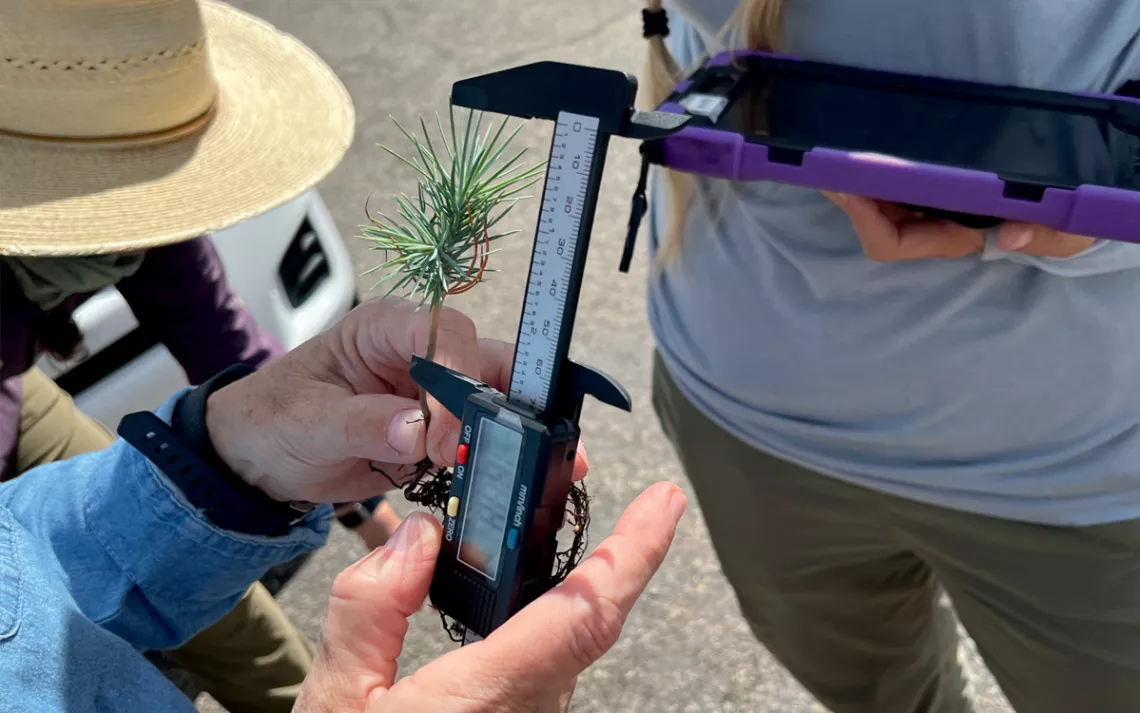
Researchers measure a sapling. | Photo by Krista Langlois
Before cell service faded, Michala Phillips, a restoration ecologist with the US Geological Survey, had been obsessively refreshing the weather forecast on her phone. A storm blowing in from the Pacific was projected to hit Mesa Verde around 11 a.m., which meant the seven scientists on this mission had four hours to dig 288 holes and plant 288 seedlings. This wasn't haphazard, stick-'em-in-the-ground planting: Each seedling came with a precise prescription. Some had to be planted next to a clump of rabbitbrush, others sheltered next to a downed log, and still others set out in the wind-whipped open. Some had mycorrhizal fungi intertwined with their roots; others did not. The goal was to determine which factors would help the baby trees thrive in a postfire environment.
Unlike many ecosystems in the western United States, piñon-juniper forests do not need fire to regenerate. In fact, these slow-growing trees thrive with as little disturbance as possible, some for up to 1,000 years. Across the arid West, 40 million acres of piñon-juniper forest store carbon dioxide and shelter and feed hundreds of species of animals, from black bears and mountain lions to piñon jays and horny toads. The Ute, Diné (Navajo), and Pueblo use the bark, nuts, berries, wood, and pitch from piñon-juniper forests, as they have for many thousands of years.
The forests that many people grew up with are changing, and fires are accelerating that change.
Tree-ring research has shown that while large wildfires are infrequent here, in their aftermath forests do regrow, albeit slowly—piñons, for instance, don't produce sizable quantities of seeds until they're 75 years old. Since the founding of Mesa Verde National Park in 1906, more than 70 percent of the land within its boundaries has burned, and most has recovered well enough that visitors rarely realize they're hiking through old fire scars.
The Long Mesa Fire was different. The decades that followed it were abnormally dry and hot, with average soil moisture half of what it had been in the 20th century. The burned forest didn't seem to be recovering. "We noticed that those piñon-junipers aren't repopulating the same areas that they used to," said Regina Lopez-Whiteskunk, an environmental advocate and member of the Ute Mountain Ute Tribe.
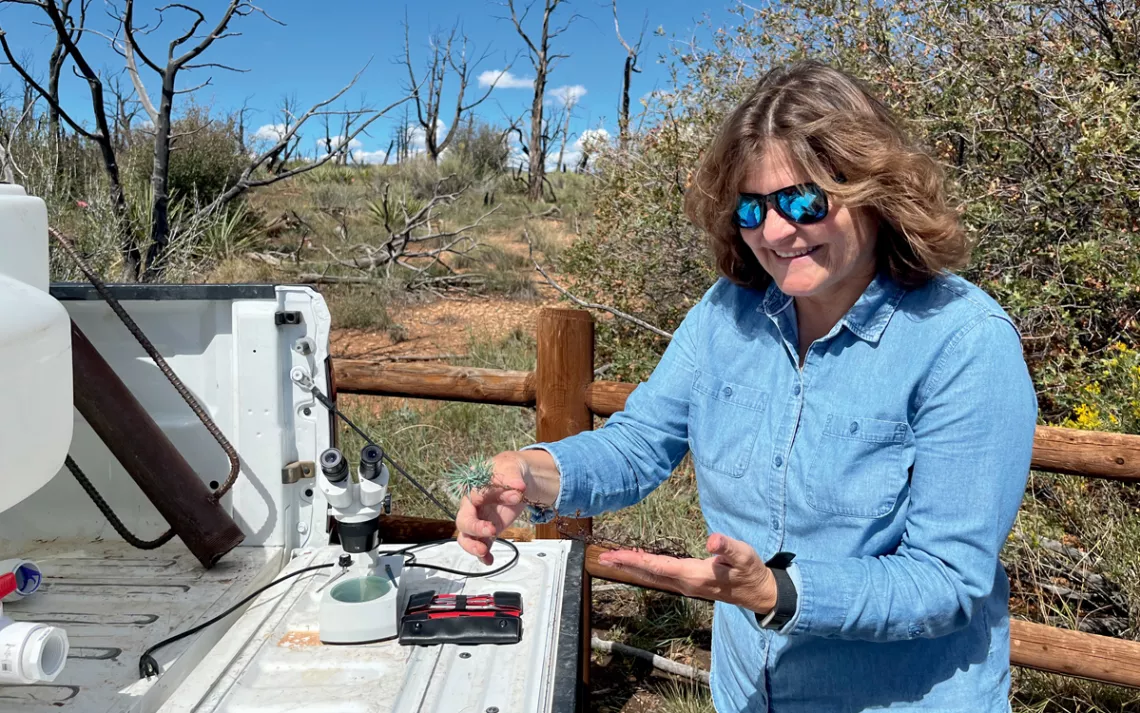
Catherine Gehring examines the mycorrhizae around a sapling's roots. | Photo by Krista Langlois
In 2021, researchers from the US Geological Survey, the Bureau of Land Management, and several colleges came to Mesa Verde and Ute Mountain Ute lands to investigate the missing trees. Their findings were bleak. "In the burn zone, we didn't find a single germinating seedling," said Brooke Osborne, a biogeochemist at Utah State University Moab. "Nothing. There's nothing coming back."
From Lake Tahoe to Yellowstone, other forests across the West are similarly failing to rebound from fires. Some are simply not regenerating at all; others are growing less robustly than expected; still others are regrowing into ecosystems that look different than they did before they burned. The forests that many people grew up with are changing, and fires are accelerating that change.
Perhaps trees are struggling to adapt to climatic shifts that typically have unfolded over hundreds or thousands of years but instead are occurring in a matter of decades.
Part of the reason is that hotter, drier conditions are fueling bigger fires that leave the land so scorched it's difficult for seedlings to take root. Exacerbating the problem are many decades of logging, overgrazing, and overzealous fire suppression; the presence of invasive species; and, of course, the effects of a changing climate. Many forests have grown unnaturally dense, jammed with dead timber and underbrush. When a lightning strike or unattended campfire sparks flames, these built-up fuels—along with highly flammable non-native grasses—turn the flames into monstrous fires that reduce the landscape to ash.
Equally important is the role of climate change in determining which species will survive in a particular environment. Fifty years ago, for instance, Mesa Verde had enough rainfall to support piñon pines and junipers. Today, drier soils and less precipitation raises the possibility that the park may be better suited to grass and sagebrush than to trees.
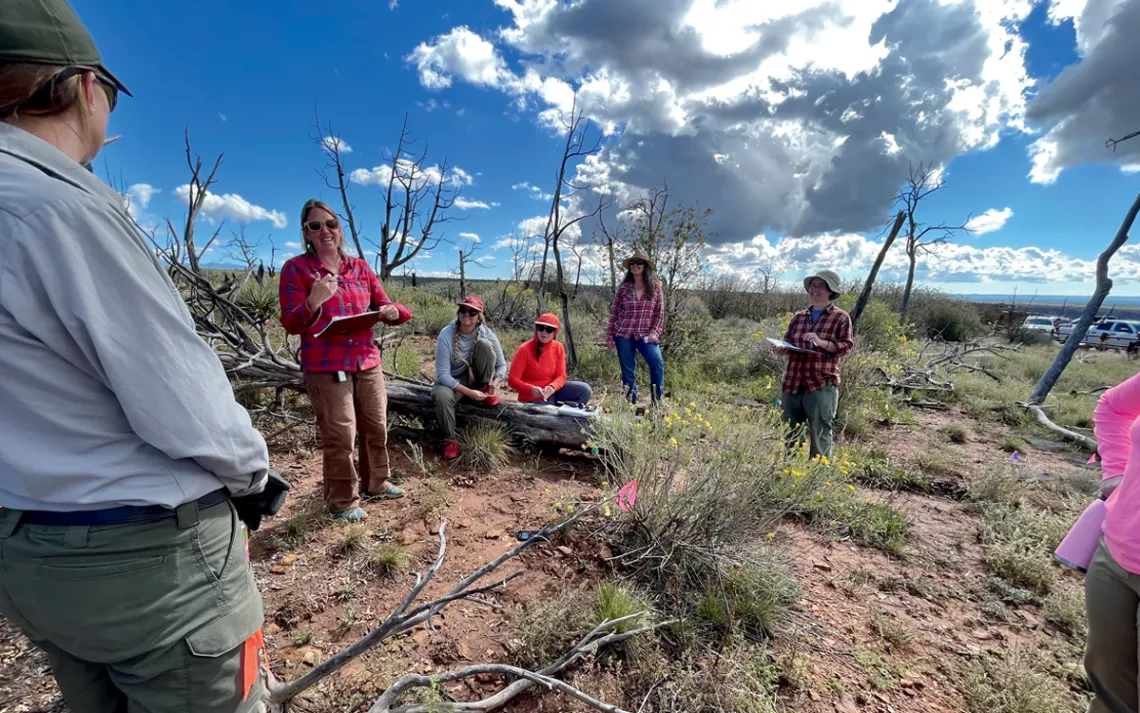
Sasha Reed briefs scientists and volunteers. | Photo by Krista Langlois
Still, given piñon-juniper forests' importance to carbon sequestration, Indigenous cultures, and species like the piñon jay—one of North America's fastest-declining bird species—Southwesterners are not giving up on one of their most iconic ecosystems. Which was why, as storm clouds built to the south, Trimber, Phillips, Osborne, and the rest of the crew were scattering over a three-quarter-acre patch of scorched earth, racing to get seedlings into the ground before the first tongues of lightning licked the mesa top.
BEYOND THE FIRE scar where the scientists were drilling holes and planting seedlings, the mesa dropped into a steep, forested canyon. Beyond that, the peaks of the La Plata Mountains pierced the brightening sky. The La Platas are part of the San Juan Mountains, which in turn are part of the Rocky Mountains' 3,000-mile spine of alpine tundra, rock, ice, and diverse coniferous forests.
In much of the Rockies, wildfire is a beneficent force. Some trees, like lodgepole pines, have seeds that need flames to germinate, while others, like ponderosa pines, have thick bark to protect them from naturally occurring, low-intensity fires. Yet beginning in the mid-2000s, scientists like Matthew Hurteau, now a forest ecologist at the University of New Mexico, began hearing stories of forests in the southern Rockies that had been totally wiped out by wildfires and were failing to regrow.
The reports reaching Hurteau's desk coincided with the start of the megadrought that still grips the American Southwest today—the worst drought in 1,200 years, and one exacerbated by human-caused climate change. By the 2010s, Hurteau said, the trend "started becoming less anecdotal and more based in data." Scientists "were starting to find complete regeneration failure" from Montana to California's Eastern Sierra.
With time, these site-specific reports coalesced into a more complete picture. In 2018, a team of scientists led by Camille Stevens-Rumann, a wildland firefighter turned fire ecologist, published a meta-analysis of existing data from 1,500 sites in temperate conifer forests across the Rocky Mountains, from central Colorado to the Canadian border. The forest sites—everything from dusty mid-elevation ponderosa pine to moist subalpine fir and spruce—had all burned between 1988 and 2011. After the year 2000, the analysis found, regeneration declined sharply across all forest types.
In most places, seedlings still sprouted but at a lower density than before the burn. Yet Stevens-Rumann and her collaborators also found that a third of the sites that had burned after 2000 experienced no regeneration at all. Just as the researchers in Mesa Verde had seen, zero tree seedlings in these places had germinated or survived.
A newer study by Kimberley Davis of the US Forest Service, Hurteau, and others that was published this year in the Proceedings of the National Academy of Sciences further contextualizes the trend. The researchers analyzed more than 10,000 plots across the West to study how climate change and wildfire intensity conspire to limit forests' ability to recover. In some places, they found, burned forests could regrow after a moderate fire but not a more severe one. In other areas, a hotter climate meant forests were unlikely to recover regardless. Between 1981 and 2000, 5 percent of burned forests were unlikely to support new conifer growth after a wildfire. By 2050, that number is expected to jump to as high as 31 percent.
"Essentially, high-severity fires are acting as a catalyst for change," Hurteau said. Among the possible shifts is "moving from forest to nonforest," like grasslands.
Another possibility is that burned forests could regrow as different types of forest, better suited to the new conditions wrought by climate change. In parts of western Colorado, for example, average temperatures are already 3.6°F warmer than they were for most of the 20th century. There, a spruce and fir forest that grew at 10,000 feet above sea level might eventually be replaced by a ponderosa pine forest, which historically grew closer to 7,000 feet and likes warmer, drier conditions. Ecologists predict that climate change will force many plant species to migrate upslope or northward.
But in many places, Hurteau said, that transition doesn't seem to be occurring naturally. Perhaps it's because modern megafires are so huge that they limit the efficacy of seed-dispersing animals like squirrels and jays. Perhaps trees are struggling to adapt to climatic shifts that typically have unfolded over hundreds or thousands of years but instead are occurring in a matter of decades. Or maybe factors that no one has yet considered are inhibiting forest regeneration. Whatever the reason, tree seedlings simply aren't growing on their own. And even where restoration ecologists have tried to replant trees, the seedlings often die. One analysis found that only a quarter of conifer seedlings planted between 2002 and 2005 in burn zones in Arizona and New Mexico survived.
Now, Hurteau and other scientists are trying to figure out how to improve that success rate. Can we help forests recover from wildfires and adapt to our more volatile climate? Different voices, meanwhile, are asking if we should even be trying.
BITS OF REDDISH dirt spewed in all directions as Phillips, the restoration ecologist, pressed a two-inch-wide drill bit into the earth. Her back ached from bending and squatting all morning, but there was little time for breaks. When the hole was nine inches deep, she turned off the drill and gently pried a piñon seedling from its container. The roots were three times longer than the aboveground sprout, a labyrinth of fine filaments dangling beneath a plume of spiky needles. Phillips nestled the roots in the hole. Then she patted soil around the seedling, doused it with water, and said a silent prayer for its survival.
"We spend a lot of time tracking bad things happening, so getting to go out onto the landscape and actively trying to improve it is really special," she said. "In a tough world where fire is burning down forests and trees aren't coming back on their own, at least in this context we're making an effort to make a place better."
Although piñon and juniper seedlings look fragile, once these trees are established, they often live where no other trees can survive, in places that receive as little as eight inches of precipitation a year. In doing so, they create habitat for a multitude of flora and fauna. "Piñon is a keystone species. So is juniper," said Renee Rondeau, an ecologist with the nonprofit Colorado Natural Heritage Program. "If you lose those species, you're going to lose a whole suite of animals. In Colorado, piñon-juniper woodlands have more species tied to them than any other type of ecosystem except riparian." Among them are numerous snakes and lizards, mammals small and large, and more than 70 nesting birds, including the gray vireo and juniper titmouse.
One of the plants associated with piñon-juniper woodlands, Rondeau said, may offer clues to why Mesa Verde's burned piñon-juniper forest isn't recovering. Chapin Mesa milkvetch thrives only in intact piñon-juniper forest in and around Mesa Verde National Park; the plant sends a perennial bulblike root deep underground and tosses up splashes of milky flowers. While monitoring the endangered plant after the 2002 Long Mesa Fire, Rondeau noticed something surprising: Milkvetch thrived in the years following the blaze but started dying wholesale a decade later. Worse yet, no new seedlings were sprouting in the burn zone.
Milkvetch roots typically draw moisture and nutrients from a strata of soil where there is no competition from other plants. After the Long Mesa Fire, land managers had seeded the area with a mixture of grasses, including some that are native to Mesa Verde but hadn't previously grown in the burned area. (Seeding with grasses after a fire is common across the West; land managers have been doing it since at least the mid-20th century to control erosion and prevent flooding and the growth of weeds in burn scars.) Rondeau noticed that the roots of those grasses occupy the same soil strata as milkvetch. The grasses, she thinks, are not just outcompeting milkvetch. They may be slowing the recovery of the piñon-juniper ecosystem in general.
"If you want to stomp things down, put grass in," Rondeau said wryly. "Grasses are incredible at keeping other things out. So by planting grasses, you're slowing succession down. And what piñon-juniper needs is to ramp up succession."
If Rondeau is right, and spraying grass seeds from an airplane after a fire turns out to be one factor slowing the recovery of piñon-juniper and possibly other forest types, the solution is simple: Stop seeding with grasses and start planting native shrubs, forbs, and trees instead.
Land managers might also improve reforestation by using transplanted seedlings that have been intentionally subjected to heat and drought to improve their tolerance for such conditions—work that's already underway in New Mexico tree nurseries run by the state and several universities. And, as in real estate, location is key. In 2016, Hurteau and his colleagues planted 768 conifer seedlings in the scar of New Mexico's 2011 Las Conchas Fire. Roughly 20 percent survived—a typical rate for the Southwest. Using data on which seedlings were successful, Hurteau and his group developed a model that uses high-resolution digital mapping to predict with 63 percent accuracy whether or not a seedling will survive. The best locations, they found, are on north-facing slopes and in slight depressions that capture pooled rainfall.
Underground fungal communities might be another factor contributing to a forest's ability to regenerate. Research by Catherine Gehring, a biologist at Northern Arizona University (and Trimber's graduate adviser), shows that fungi make the difference in whether a mature piñon lives or dies during a drought. Fungi's thin filaments can squirm into crevices too narrow for tree roots, and they can also spread farther from a tree's trunk than roots can. "Fungi are really good chemists," Gehring said. "And they can access resources that plants can't."
Unnaturally severe wildfires scorch underground fungal communities in much the same way they do aboveground plant communities. "Even 20 years after a fire, the diversity of fungi just isn't there compared to what we find in the soils from intact woodlands," Trimber said. If mycorrhizae are revealed to be a main factor determining whether seedlings survive at the Mesa Verde study site, land managers could one day inoculate burn scars with local fungi just like they now seed with grasses. "The data suggest that much of what's happening above ground is dependent on what's going on below ground," said Sasha Reed, an ecologist with the US Geological Survey. "It's so rad."
As scientists learn more about why trees aren't regrowing after wildfires, it's becoming apparent that while climate change fuels fires and hinders trees' ability to recover, it acts in concert with a suite of other factors. And while climate change is a massively complex problem that could take decades to mitigate, the ways that managers treat a landscape before and after a fire is something that can be changed comparatively quickly. "I think that with thoughtful decision-making in the way we go about interacting with these landscapes after wildfire, we can restore more forest than you would expect, given the results of some of these postfire planting activities," Hurteau said. "The situation is not as dire as it seems."
AS THE FIRST thunder rumbled in the distance and raindrops kissed the dry soil, Phillips, Trimber, and the others straightened up and stretched. They'd managed to get all 288 seedlings planted. It was time to head to a lower elevation to wait out the storm.
For the next day and a half, rain pounded the mesas and mountains of southwest Colorado. After the storm abated, an expanded crew of scientists returned to Mesa Verde.
The storm had rinsed the land clean, and the sky was a luminescent blue. A raven quorked from the skeleton of a dead tree, and multicolored flags fluttered in the breeze, each marking the location of a piñon or juniper seedling. "Aren't they so cute?" Reed said, squatting next to one and brushing her fingers against its needles. "Baby piñons! Don't they look like pure hope?"
Decked out in sun shirts and wide-brimmed hats, the scientists spread out to collect every possible piece of data, including information on each seedling's height and width, the physical attributes of its immediate surroundings, which plants it might compete with, how much shade it received, the temperature of the soil, and whether the seedling had been inoculated with mycorrhizae. Over the next few years, scientists will monitor the seedlings to see which factors correlate with the highest survival rates. In doing so, they hope to pass on practical information that land managers can use in other burn zones—a simple, scalable prescription for how and where to put piñon and juniper trees in the ground to maximize their chances of success.
Planting seedlings is more labor-intensive than broadcasting grass seeds from an airplane, and it will never be feasible to replant every burned acre in the West. But by targeting specific areas—like cooler, north-facing slopes or areas with high cultural importance, like near cliff dwellings at Mesa Verde—it might be possible to give native forests the foothold they need to expand on their own. The best strategy of all, Hurteau believes, is to prevent high-intensity wildfires in the first place. If we can help forests be more resilient before they burn, we may ultimately lose fewer than we will if we only try to repair the ones that have already burned. In some places, this might mean using prescribed burns; in others, thinning overly dense forests to remove younger trees and leave the most mature; and in others, taking drastic measures to protect iconic ecosystems and old-growth trees. In 2021, conservationists in California wrapped giant sequoias in aluminum-foil-like blankets to protect them from abnormally hot fires.
Elsewhere in the West, land managers are already planting trees better suited to the predicted climate of the future, rather than the one we have now. New Mexico's 2020 "forest action plan," for instance, directs foresters to plant "the right tree in the right place for the anticipated 2100 climate," as predicted by up-to-date modeling maps. This might mean planting piñons and junipers in places formerly occupied by ponderosa pines.
Might it also mean giving up on piñons and junipers entirely in some places? "I think there may be a time when we have to give up on certain species in certain environments," Reed said. "I just don't want us to give up too soon, before we've really tested the ability of these organisms to respond to change. So if it's mycorrhizae or some piece of the puzzle we haven't put in place yet, I want to keep trying before we move to a place where we don't try anymore."
A FEW MILES from the scar of the Long Mesa Fire, a trail winds through one of Mesa Verde's best examples of old-growth piñon-juniper forest. Although this forest lacks the lush decadence of preindustrial forests in the Pacific Northwest, it's spectacular in its own quiet way. Some of the junipers are at least 400 years old, and in the warm September sun they release a bittersweet aromatic compound reminiscent of cedar. The scaly bark of piñons likewise drips with resinous pitch. Together, the trees' smell embodies autumn in the Southwest—wood smoke and roasting chiles, crisp air and star-choked nights.
While the afternoon light in the burn scar was harsh, the light in the old growth was more muted. Beneath a 30-foot-tall juniper, the ground was carpeted with moss—moss, in the high desert at 7,000 feet elevation, far from any springs or seeps. The trees create their own microclimate, one that's more forgiving for seedlings to take root. Here, young piñon and juniper trees of various ages and sizes—from three-inch babies to knee-high teenagers—grow on their own, without human intervention.
Lopez-Whiteskunk, the Ute environmental advocate, said that in her own wanderings on Mesa Verde, she's seen piñon and juniper seedlings sprouting, even in old burn scars. "These little groves are starting," she said. "Just not in the places that we expect them or want them. They're finding their new locations on their own."
Unlike the restoration crew, Lopez-Whiteskunk doesn't believe piñon-juniper forests need our help. Forests operate on their own slow timescales, she said, with their own incomprehensible and sometimes random logic. Given enough time and space, piñons and junipers will migrate and adapt to the changing climate on their own.
"One of the things I've heard a lot of elders speak to over the years is how we're not giving these locations time to rest," she said. "In our culture, when we recognize that a certain location has been overharvested or something isn't right, we leave it be. I think part of our downfall is assuming that we can help [the earth], when sometimes the answer is to just let her heal herself."
The full recovery or migration of burned forests may not unfold in our lifetime, or even our children's lifetime. But "in the cycle of the history of our planet, these events have all happened before," Lopez-Whiteskunk said. "The environment is resilient. There's things that are bigger than we are."
Regardless of whether forests adapt on their own or if people help them along, nearly everyone I spoke with agreed on this takeaway: No matter how much effort people put into saving the West's forests, some will likely be lost—to our past mistakes, to the changing climate, to fire, to disease, and to our continued thirst for development. But though some recent studies have predicted the end of piñon-juniper forests in the Southwest or a future in which some states lose up to half their native forests, such models don't account for the cadre of scientists and conservationists working to change course. Thanks to their work, we don't necessarily face a future without trees. The forests of the future may look different from the dense stands of trees we've known in the past, but in some ways they may be healthier—less homogenous, more resilient, and more beloved because of the many hands and hearts that have planted and tended and prayed for them.
 The Magazine of The Sierra Club
The Magazine of The Sierra Club

